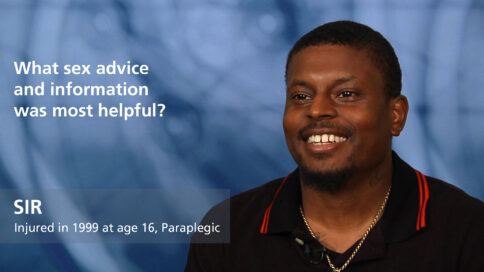How is sexual function in men affected by a spinal cord injury? - Diane M. Rowles, MS, NP
|
|
How is sexual function in men affected by a spinal cord injury? |
|
Diane M. Rowles, MS, NPNurse Practitioner, Spinal Cord Injury Rehabilitation Program, Rehabilitation Institute of Chicago |
||
| Read Bio | More Videos by Diane M. Rowles | |
|
Share |
||
Transcript
So let start first with the anatomy, and I think that will help. In the spinal cord, there’s two areas that control sexual function. One is from T11, and some books will say T10, to L2. The other is S2 to S4. T11 to L2 for men controls what we call psychogenic erections, erections where the stimulus is in the brain—seeing somebody naked, looking at a magazine, dreaming where the stimulus starts in the brain. That stimulus goes down the spinal cord; the T11-L2 center flips it out and stimulates a psychogenic erection. The S2 to S4 center is a reflexic center, and what I mean by reflexes is that the message doesn’t have to go to the brain for a reflex to work. A reflex, the message goes into the spinal cord, loops around and comes back out. So people who have injuries high up in the cervical level, the high thoracic level, if their injury is complete, meaning no messages are getting through, then they’re likely not to have psychogenic erections. But all of the damage to their spine, all of the swelling is high up in the spine. The bottom part of their spine, that S2-S4 part of their spine, is intact and working, it’s just not connected to the brain. So the reflexes can go through that part of the spine, it’s actually called the sacral arc reflex, and there’s many reflexes that go through that area. But the reflex erections, so reflex erections are erections stimulated by rubbing the inside of a thigh, masturbating, playing with public hair, catheterization anything that’s external, the message goes into the spine, loops around and comes back out and stimulates an erection. So like I said, people who have higher injuries have more reflex erections, less psychogenic, if their injury is complete. Okay, now people who have low injuries, below L2, the very low paras, the damage and the swelling is at the bottom of the spine, more likely to interfere with the reflexes. They’re not as likely to have spasms and other reflexes. But, that T11-L2 center is still connected to the brain, so they get psychogenic erections. So for men after spinal cord injury, most men after spinal cord injury get some kind of an erection, whether it’s psychogenic , whether reflexogenic. There are a handful of men, and usually it’s right in that T11-L2 center, that may not get any erection at all, but that’s not the majority of people. So we have psychogenic and reflexogenic. The other thing about reflexogenic erections is that most people will say that they can get an erection, but they can’t always get it when they want it, it doesn’t always get hard enough, or it doesn’t always stay long enough. That’s the vast majority. Other people say they can get it every time they want it, it gets hard enough, it lasts long enough and they’re fine. Other people say they don’t get any.
Show Less|
|
||
add
How is sexual function in men affected by a spinal cord injury? |
||
Diane M. Rowles, MS, NPNurse Practitioner, Spinal Cord Injury Rehabilitation Program, Rehabilitation Institute of Chicago |
More Videos by Diane M. Rowles | |
| Transcriptadd | share | |
So let start first with the anatomy, and I think that will help. In the spinal cord, there’s two areas that control sexual function. One is from T11, and some books will say T10, to L2. The other is S2 to S4. T11 to L2 for men controls what we call psychogenic erections, erections where the stimulus is in the brain—seeing somebody naked, looking at a magazine, dreaming where the stimulus starts in the brain. That stimulus goes down the spinal cord; the T11-L2 center flips it out and stimulates a psychogenic erection. The S2 to S4 center is a reflexic center, and what I mean by reflexes is that the message doesn’t have to go to the brain for a reflex to work. A reflex, the message goes into the spinal cord, loops around and comes back out. So people who have injuries high up in the cervical level, the high thoracic level, if their injury is complete, meaning no messages are getting through, then they’re likely not to have psychogenic erections. But all of the damage to their spine, all of the swelling is high up in the spine. The bottom part of their spine, that S2-S4 part of their spine, is intact and working, it’s just not connected to the brain. So the reflexes can go through that part of the spine, it’s actually called the sacral arc reflex, and there’s many reflexes that go through that area. But the reflex erections, so reflex erections are erections stimulated by rubbing the inside of a thigh, masturbating, playing with public hair, catheterization anything that’s external, the message goes into the spine, loops around and comes back out and stimulates an erection. So like I said, people who have higher injuries have more reflex erections, less psychogenic, if their injury is complete. Okay, now people who have low injuries, below L2, the very low paras, the damage and the swelling is at the bottom of the spine, more likely to interfere with the reflexes. They’re not as likely to have spasms and other reflexes. But, that T11-L2 center is still connected to the brain, so they get psychogenic erections. So for men after spinal cord injury, most men after spinal cord injury get some kind of an erection, whether it’s psychogenic , whether reflexogenic. There are a handful of men, and usually it’s right in that T11-L2 center, that may not get any erection at all, but that’s not the majority of people. So we have psychogenic and reflexogenic. The other thing about reflexogenic erections is that most people will say that they can get an erection, but they can’t always get it when they want it, it doesn’t always get hard enough, or it doesn’t always stay long enough. That’s the vast majority. Other people say they can get it every time they want it, it gets hard enough, it lasts long enough and they’re fine. Other people say they don’t get any.































